Why the $5 Gold Liberty Head Remains America's Most Treasured Coin
The $5 gold liberty head is one of the most significant coin series in American numismatic history. Also known as the Liberty Head Half Eagle, it was minted for 70 years (1839-1908), a period that saw the California Gold Rush, the Civil War, and America's rise as a global power.
Key Facts About the $5 Gold Liberty Head:
- Production Period: 1839-1908 (70 years)
- Gold Content: 0.24187 troy ounces of pure gold
- Two Types: "No Motto" (1839-1865) and "With Motto" (1866-1908)
- Mints: Seven different U.S. Mints produced these coins
- Current Value: Ranges from around $300 for common dates to over $25,000 for rare specimens
- Rarity Factor: Most coins were melted down following Executive Order 6102 in 1933
The Liberty Head Half Eagle is the only coin design struck at all seven U.S. Mint locations of its era. This, combined with the 1933 government gold recall that melted millions of coins, creates a fascinating market where common dates are accessible while rare mint marks command high prices.
Today, the coin offers both historical significance and tangible value. Each coin contains nearly a quarter-ounce of gold, providing intrinsic value alongside numismatic potential. It appeals to those diversifying with physical assets that have proven their resilience for over a century.
As Eric Roach, I've guided clients in precious metals for over a decade. My experience shows that pre-1933 gold coins like the $5 gold liberty head offer unique advantages over modern bullion, combining gold's stability with the potential for collectible appreciation.
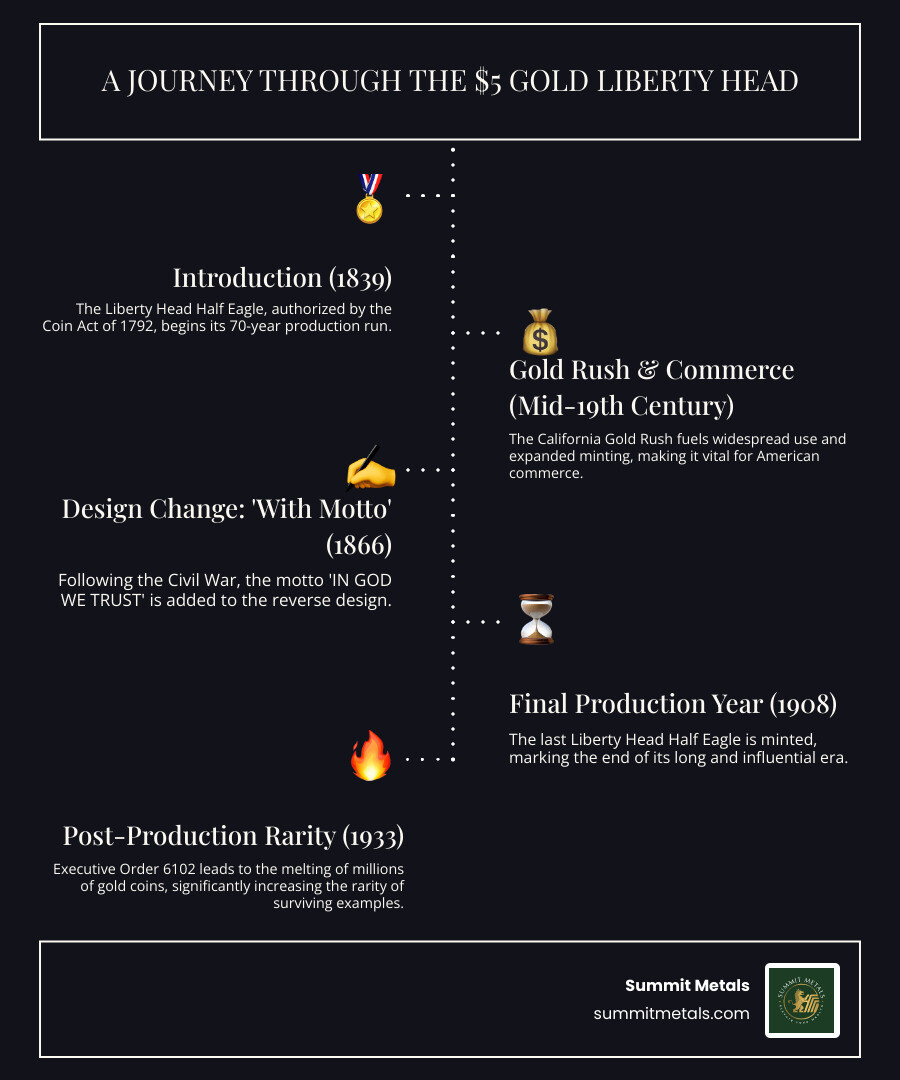
A Journey Through American History
The $5 gold liberty head tells the story of America. The Coin Act of 1792 authorized the Half Eagle, one of America's first gold coins, to establish the young nation's credibility on the world stage.
Throughout the 19th century, these gold coins were the backbone of American commerce. A single coin held significant purchasing power, fueling everything from daily life to cross-country trade.
The 1849 California Gold Rush revolutionized U.S. coinage. A massive influx of gold led to increased production of $5 gold liberty head coins, which circulated widely as the nation expanded.

But the coin's most dramatic chapter began on April 5, 1933. During the Great Depression, President Franklin D. Roosevelt signed Executive Order 6102, requiring citizens to turn in their gold coins, including millions of $5 gold liberty head Half Eagles.
The government's goal was to combat the economic crisis by increasing the money supply. However, the result was "the great melting"—a massive destruction of America's numismatic heritage. Coins that had survived the Civil War and witnessed America's expansion were unceremoniously melted into gold bars. Millions of $5 gold liberty head coins vanished forever.
Ironically, coins that helped build American prosperity were sacrificed to restore it. When private gold ownership was legalized again in 1974, collectors finded that once-common dates had become rare treasures.
Today, every surviving $5 gold liberty head is a tangible link to this history. It's a survivor of a pivotal government intervention, which is why even common dates command premiums far above their gold content—they're not just coins, they're pieces of history.
Anatomy of a Classic: Design and Specifications
The $5 gold liberty head is a masterpiece of American coinage, designed by Christian Gobrecht, the U.S. Mint's third Chief Engraver. His enduring neoclassical design graced American coinage for nearly seven decades, becoming one of the most recognizable in U.S. Mint history.
Obverse and Reverse Features
The obverse (front) features Lady Liberty in a left-facing profile, wearing a coronet inscribed with "LIBERTY." Thirteen stars, representing the original colonies, surround her, with the minting year below.
Turn the coin over to the reverse (back), which displays a magnificent Heraldic Eagle with outstretched wings. It clutches an olive branch (symbolizing peace) and arrows (representing readiness to defend freedom). The inscriptions "UNITED STATES OF AMERICA" and "FIVE D." complete the design.
Key Variations and Specs
A significant design change during its 70-year run created two distinct types, making the series interesting for collectors.
Type 1 'No Motto' (1839-1865) is the original Gobrecht design, minted during the Gold Rush and Civil War.
Type 2 'With Motto' (1866-1908) was created after the Civil War when Congress mandated adding the motto "IN GOD WE TRUST" on a ribbon above the eagle, reflecting a shift in national sentiment.
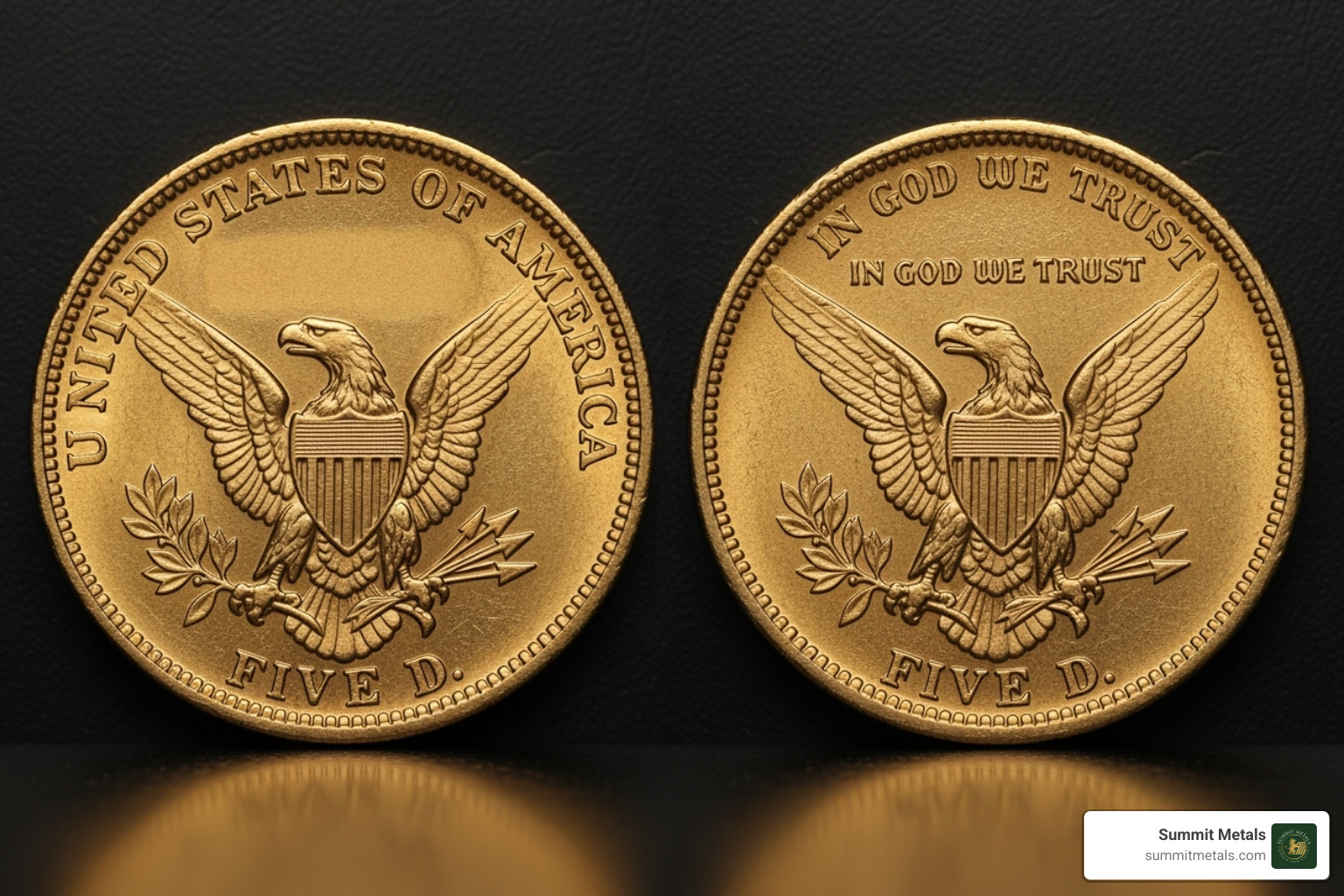
The coin's specifications are as impressive as its design. Each contains 0.24187 troy ounces of pure gold. Its 90% gold composition (alloyed with 10% copper) ensured durability for circulation.
With a total weight of 8.359 grams and a diameter of 21.6 mm, the coin has a satisfying heft. This gold content gives even common, lower-grade examples significant intrinsic value, making them a tangible store of wealth.
Understanding the Value of a $5 Gold Liberty Head
The value of a $5 gold liberty head extends beyond its gold content. Unlike modern bullion, these historic coins carry a numismatic premium—the added value from their rarity, condition, and historical significance. Think of it like a rare book: its story and scarcity add value beyond the raw material.
Grading, Mints, and Rarity
A coin's condition, or grade, is critical to its value. Professional graders use the Sheldon Scale (1-70) to provide a universal standard.
- Circulated coins show wear from use and are more affordable.
- Uncirculated (Mint State or MS) coins were never used and retain their original detail. Higher MS grades command the highest prices.
Certification matters. Coins graded and sealed by services like PCGS or NGC are authenticated and have a guaranteed grade. At Summit Metals, we recommend certified coins to protect your investment and ensure liquidity.
The mint mark also dramatically affects value. These coins were struck at seven U.S. Mints: Philadelphia (no mark), Charlotte (C), Dahlonega (D), New Orleans (O), San Francisco (S), Carson City (CC), and Denver (D). Coins from southern mints (C, D) and Carson City (CC) are especially prized for their rarity and history.
The value difference can be staggering. A common 1901-S in XF-40 condition might be worth $900-$1,200, while a rare 1870-CC in the same grade could fetch $15,000-$20,000. In MS-62, that same CC coin could reach $30,000-$40,000. Prices are approximate and subject to market changes.
For detailed mintage figures and current market values, the NGC Coin Explorer is an invaluable resource.
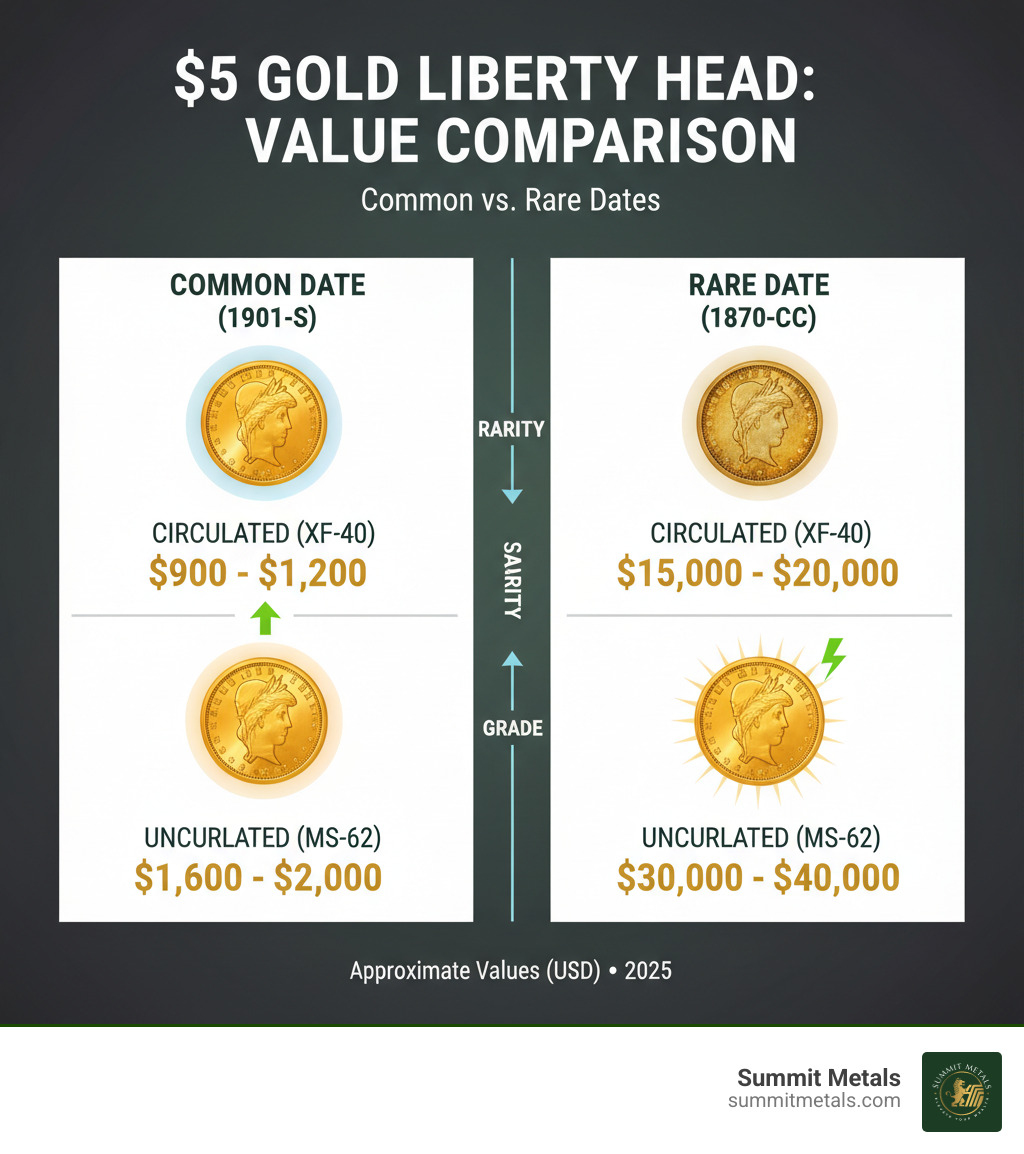
This value difference highlights the importance of understanding grades and mint marks. Common dates offer solid gold value with numismatic potential, while rare dates can be true treasures.
A Guide to Collecting and Investing
Collecting pre-1933 gold like the $5 gold liberty head means owning tangible history while protecting your wealth. These coins are both collectibles and solid investments, offering diversification that paper assets can't. Unlike paper assets, each coin contains physical gold, making them appealing during uncertain economic times as a store of intrinsic value.
The Most Sought-After $5 Gold Liberty Head Coins
Certain dates and mint marks are the crown jewels of the series.
- Carson City (CC) issues are among the most coveted due to the Wild West mint's short operating period and low mintages. The 1870-CC is a key rarity, with values reaching $37,500 in MS-40 grade. Prices are approximate.
- Dahlonega (D) and Charlotte (C) issues are also rare, originating from early southern gold mines. The 1861-D is a famous rarity, valued up to $35,000 in MS-40. Prices are approximate.
- Even the main Philadelphia mint produced some low-mintage dates that are now highly collectible.
The Future Outlook for the $5 Gold Liberty Head
The future outlook for these coins is promising. As pre-1933 U.S. gold, they are an excellent hedge against inflation. A diminishing supply of high-grade examples, due to the 1933 gold recall and natural attrition, meets growing collector demand. This classic supply-demand scenario creates a compelling investment case.
Investing in Gold: Coins vs. Bars
When adding physical gold to a portfolio, investors choose between coins and bars. While Summit Metals offers both, historic coins like the $5 gold liberty head have unique advantages.
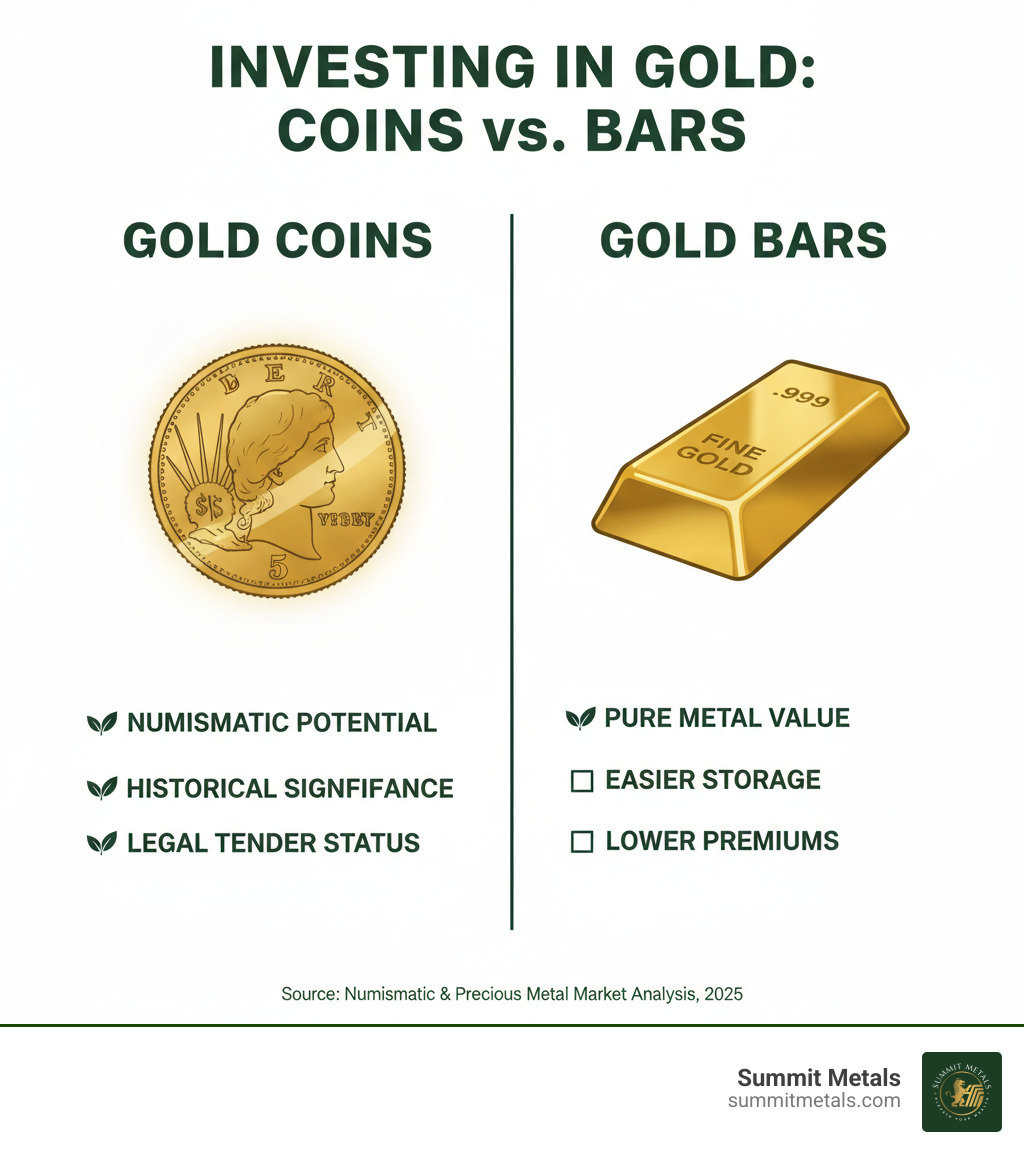
- Numismatic Potential: Historic coins can appreciate based on rarity and condition, offering upside beyond their gold content—an advantage bars don't have.
- Legal Tender & Fraud Protection: As official U.S. currency, these coins have legal tender status. Their intricate designs and the established certification process make them harder to counterfeit than generic bars.
- Historical Significance: Owning a $5 gold liberty head connects you to major events in American history, an intangible value bars lack.
- Portability and Divisibility: Coins are easier to transport and sell in smaller, more flexible units than large gold bars.
While gold bars have lower premiums, historic coins offer a compelling blend of security and collectible potential.
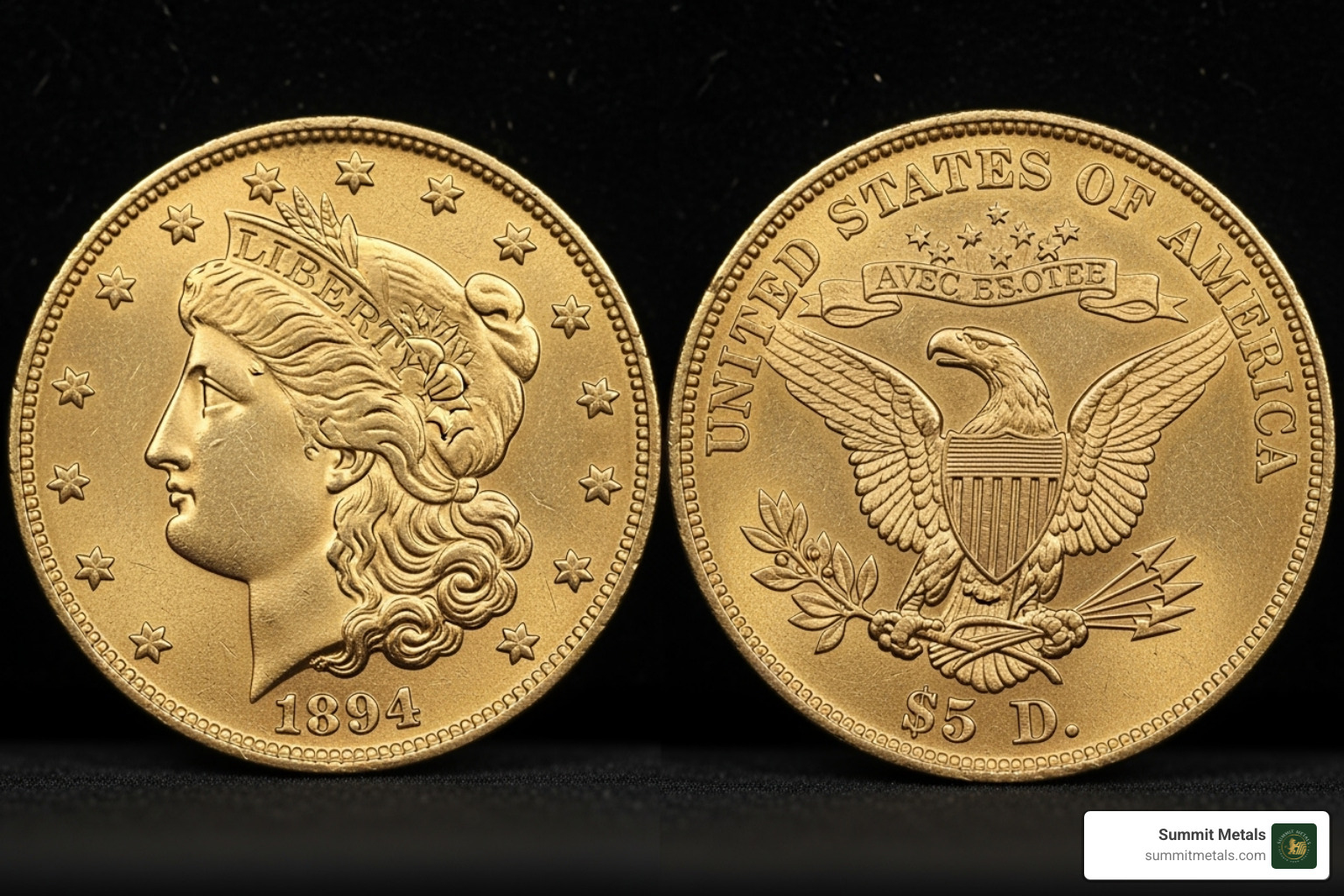
How to Start Your Collection
Starting a $5 gold liberty head collection is an exciting journey. These coins offer a unique blend of history and value that modern bullion can't match.
Finding Reliable Information and Buying Smart
A key principle in collecting is: "Buy the book before the coin." Before purchasing, research the series. Understand the mint marks, the two major types ('No Motto' and 'With Motto'), and how grading affects value. Online resources like the complete U.S. coin history provide a great foundation.
- Start with common dates in higher grades. A high-grade common date coin is an affordable way to appreciate the design and learn about the series before pursuing rarer pieces.
- Work with a reputable dealer. At Summit Metals, our reputation is built on trust, transparent pricing, and competitive rates. We are based in Wyoming and deal only in authenticated precious metals.
- Verify authenticity. Always opt for coins professionally graded by services like PCGS or NGC. The added cost ensures authenticity and condition, providing essential peace of mind.
Building Your Collection with Autoinvest
For long-term collectors, building a collection takes time. Market timing is difficult, which is why our Autoinvest program is so effective. Think of it as a 401k for precious metals.
This program uses dollar-cost averaging, allowing you to make consistent monthly purchases. This strategy smooths out price fluctuations over time, helping you build a valuable collection without the stress of market timing. This approach makes collecting accessible, allowing you to gradually accumulate coins within your budget.
More info about our Autoinvest services is available on our website, where you can see how easy it is to set up automatic monthly purchases custom to your budget and collecting goals.
Frequently Asked Questions about the $5 Liberty Gold Coin
Here are answers to the most common questions we receive at Summit Metals about the $5 gold liberty head coin.
How much is a $5 Liberty Head gold coin worth?
The value varies greatly. A coin's worth depends on its baseline melt value (from 0.24187 troy ounces of gold) plus its numismatic value, which is determined by three key factors:
- Rarity: A rare date like an 1870-CC is far more valuable than a common 1881-S.
- Grade (Condition): A pristine, uncirculated coin is worth much more than a heavily worn one.
- Mint Mark: Coins from branch mints like Carson City (CC), Dahlonega (D), and Charlotte (C) often carry high premiums.
A common, circulated coin might be worth $400-$600, while a rare, high-grade example can be worth tens of thousands of dollars. Prices are approximate and subject to market changes.
What is the difference between the two types of Liberty Head Half Eagles?
The difference is on the reverse and reflects a key moment in American history.
- Type 1 'No Motto' (1839-1865): The reverse features the heraldic eagle with no motto above it.
- Type 2 'With Motto' (1866-1908): Following the Civil War, Congress mandated adding the motto "IN GOD WE TRUST" on a ribbon above the eagle.
This change makes the series particularly appealing to collectors, as it captures a pivotal moment in U.S. history.
Are $5 Liberty gold coins a good investment?
Yes, they are an excellent choice for both collectors and investors. They offer a unique combination of intrinsic value from their gold content and numismatic potential for their value to grow far beyond the gold price due to rarity and demand.
They serve as an excellent hedge against inflation and a way to diversify with a tangible asset. The combination of a diminishing supply and growing demand points to strong long-term appreciation potential. Our Autoinvest program allows clients to build a collection over time using a dollar-cost averaging strategy, similar to a 401k.
Conclusion
Holding a $5 gold liberty head Half Eagle connects you to nearly two centuries of American history, from the California Gold Rush to the Great Depression. This is authentic American history you can own—a coin that may have been in a prospector's pocket before being recalled by the government in 1933.
For collectors, the coin offers Christian Gobrecht's timeless artistry and a narrative of a nation's history, reflected in the 'No Motto' and 'With Motto' designs.
For investors, it provides a tangible asset with nearly a quarter-ounce of gold, plus the potential for numismatic appreciation. It's portfolio diversification with a historical narrative.
At Summit Metals, trust is paramount. Our Wyoming-based team provides only authenticated precious metals with transparent pricing and competitive rates, ensuring you receive genuine value.
Our Autoinvest program makes starting easy. It allows you to use dollar-cost averaging to build a tangible collection of American history over time, much like a 401k.
The $5 gold liberty head is more than an investment; it's a piece of the American story, connecting our past with enduring value for the future.
Ready to start your collection? Start building your precious metals portfolio today and find why investors and collectors trust Summit Metals.



